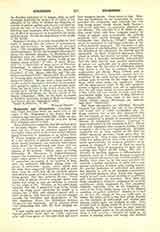

Biogenesis and Abiogenesis.—According to their Greek derivation these two terms refer to the origin of life. Biogenesis is the theory that life originates only from preexisting life; whilst the theory of abiogenesis implies that life may also spring from inorganic matter as such.
Some philosophers maintain that life existed prior to inorganic matter. Thus Fechner considers the stars and the universe as conscious organic beings of a higher order, which in the course of time differentiated themselves to organisms of an inferior kind. W. Preyer imagines the present world of organisms as a last remnant of gigantic primeval organisms, whose breath, perchance, was luminous iron-vapour, whose blood was liquid metal, and whose food meteorites—a fantastic conception which offers no solution of the problem. Others, again, as Liebig, Helmholtz, W. Thompson, E. Dubois-Reymond, assume the transference of small living germs from other cosmic globes to our cooling earth by means of meteorites—an evasion of the question at issue, with the additional difficulties arising from the nature of meteorites. Lastly, others admit that life must have originated somewhere and at some time, since our earth and all the celestial spheres were once in a state of fusion, incapable of sustaining living germs. But here opinions diverge. Those who deny a special directive principle assert that matter and energy as such are sufficient to account for the origin of life. Vitalists, on the other hand, maintain that life is generated from living beings only; its origin must ultimately be sought in a creative act of God, who endowed matter with a force sui generis that directed the material energies towards the formation and development of the first organisms. Hence the distinction between abiogenesis and biogenesis. Let us examine which view harmonizes best with the facts actually observed.
A most careful and universal research has proved beyond prudent doubt that all visible organisms arise only from germs of the same kind and never from inorganic matter. Omne vivum ex vivo. However the conditions of the experiment be varied, provided the receptacles and materials are free from living germs, results always verify Pasteur’s well-known aphorism: La generation spontanee est une chimere. The attempts of J. B. Burke to produce small living cells from inorganic matter by means of radium were unsuccessful; the radiobes produced were merely bursting gas bubbles of microscopic size. Similarly, Pfluger’s cyanic acid, which he compared to half-living molecules, is but a dead chemical compound. The formation of cells by a process of crystallization, as was assumed by the founders of the cell-theory has likewise proved unfounded. In short, Virchow’s statement, Omnis cellula ex cellula, has become an axiom of biology. Now, it is a principle universally acknowledged that the laws derived from present observations of nature are applicable also to past phenomena. How, then, can the defenders of abiogenesis uphold their theory in the face of contrary facts?—Two explanations are offered. Many authors, such as Halliburton, Verworn, Rosenthal, assume that the conditions of the earth during earlier periods were perhaps more favorable for the origin of life than those which come under our experience. Others call the spontaneous origin of life from inorganic matter a logical necessity, and add as explanation that the cell must consist of more primitive units of life, which will ever remain invisible, and whose spontaneous origin from matter is thus withdrawn from observation. These units of life have received various names; Weismann, for instance, calls them “biophorids”.
But these assumptions are arbitrary. Scientific research has established the cell as the simplest and lowest unit of visible independent life. No living organism has as yet been discovered that did not contain at least two essential elements of great complexity: a granule of chromatin and some amount of cytoplasmic substance. Deprived of these constituents no cell continues to live. Hence, if life ever originated from inorganic matter, it had to appear in the form of an organized cell. Invisible biophorids are no more capable of life than the visible chromatin granules, whose parts they are supposed to be. Even if such entities as biophorids could live independently, they could not have originated spontaneously; for however primitive an organism be imagined, it must at least be capable of nourishing itself, of propagating its kind, and of evolving into higher specific forms. But such a diversity of function supposes a differentiation of structure, made up of different chemical compounds of high tension and continuously unstable equilibrium. Besides, there must be in the most primitive biophorids a perfect correlation of parts and a purposeful anticipation of future ends, tending towards the gradual perfection of individual and species. But crystals, as well as all chemical combinations and physical mixtures, show clearly that inorganic matter as such tends toward stability of equilibrium and homogeneity of structure. How, then, did those complicated chemical compounds of unstable equilibrium which composed the first organisms originate, especially since, at the beginning, the crust of the earth, totally burnt, was in the desolate condition of perfect oxidation? Besides, it is hard to see how the energy of the sun could serve to reduce the ashes, since today that action depends on the presence of chlorophyll and similar substances, which again are products of cells. Even if some form of energy would all at once commence continually to unite the atoms to such unstable and complicated bodies as the phosphoric proteids, there is still wanting a directive to build up, by means of existing matter and energy, the chemical compounds into correlated structures, and to make them active organisms.
Matter, then, can never, not even under the most favorable circumstances, produce either living cells or living biophorids, and hence we conclude that life owes its origin to God, the Creator of matter and energy.
H. MUCKERMANN

